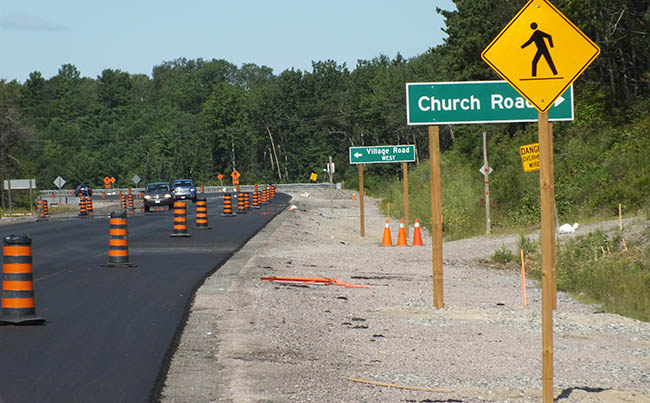Drivers will now need to slow down by Serpent River

By Leslie Knibbs
SERPENT RIVER – After a meeting on highway safety eight months ago, things are improving for Serpent River First Nation (SRFN). Reconstruction of the Trans-Canada Highway running through the community is in progress and most of the concerns brought up at the highway meeting are being addressed in an effort to improve safety for all. As a result of ongoing consultation with citizens, the words of both the community and the Ministry of Transportation have turned into positive action.
“The bottom line is we want to see the speed limit dropped,” said Chief Elaine Johnston at the community meeting back in October of 2016 where representatives of MTO and their consulting firm AECOM were present to discuss residents’ safety concerns on the Trans-Canada Highway 17 cutting through Serpent River. John Fraser and Doug Herbrand, both senior MTO managers, as well as engineers Ilya Sher, Raymond Hang and Hossein Zarei from Aecom (consulting firm for MTO) spoke to Serpent River citizens.
Fraser, manager of engineering for the Northeastern Region of the MTO told those at last year’s meeting that many of the concerns are the same as other small communities along the highway. The speed limit on the SRFN portion of the Trans-Canada had been 90 km per hour creating a safety issue for citizens until recently the problem of safety was exasperated with a passing lane which led to increased vehicular speeds. “We cannot engineer good driving behaviour,” Fraser told those at the October meeting.
The MTO is responsible for setting speed limits on provincial highways. A check on other communities along the North Shore and Manitoulin Island reveals the highway speed limit of 90 km per hour in SRFN is at least 20 km higher than other small communities where the speed limit is reduced to 70 km per hour. In two cases, the speed limit is reduced to 50 km per hour. First Nations on Manitoulin Island including Sheguiandah, Aundeck Omni Kaning and M’Chigeeng, have speed limits of 50 km and 70 km per hour. The highways running through these communities are not major highways like Highway 17 in SRFN, but rather are smaller regional highways such as Highway 540 where the speed limit is 90 km also outside of the community.
“We are the only First Nation where the speed limit is 90 along the North Shore, but traffic goes by at 110 kph,” said local resident Carol Meawasige. According to Chief Johnston, the speed limit will be reduced to 70 km per hour when construction is completed. After making a request to have the new signs up during construction, the signs were up by August 14.
With no reduction in the speed limit on this highway as well as the passing lane, increased speeds have resulted in many accidents in the past causing fatalities as well as near misses. The SRFN Elders Lodge, Geka Wigwam, is located directly across the highway from Our Lady of Highway Church. A pedestrian walking sign has been in place here for some time however, this section was until recently four lanes across with a passing lane. Many of the Elders attend church, and move slowly when crossing the highway.
Chief Johnston has in the past approached the OPP about making the section of the highway running through her community a “Community Safety Zone”, but according to one councilor she was told, “they [OPP] don’t have enough manpower to enforce a Community Safety Zone [in SRFN].” Whether or not the much needed “Community Safety Zone” signage will be installed following reconstruction remains to be seen. Making the stretch of highway running through SRFN a community safety zone will have a deterrent effect on speeding with the doubling fines if a driver is caught speeding. Clearly the installation of these signs on this stretch of the Trans-Canada Highway where there is much pedestrian traffic would be “another tool in the toolbox” to reduce speeding and possible accidents. In the past the OPP’s response to a request for this signage has been there is a lack of manpower to enforce this.
As it stands now, the new highway will be reduced to two lanes, there will be no passing lane, shoulders will be widened for pedestrian traffic and a bicycle lane will be installed. Aboriginal Liaison Officer Dwayne Pamajewon with the Aboriginal Relations Branch of the MTO is keeping an eye out assuring all the community’s concerns are addressed allowing for a safer community along the highway in SRFN.
Having senior management individuals from the MTO and the consulting engineer company responsible for designing safe highways at last October’s meeting spoke volumes to the MTO’s willingness and obligation to consult with a community with legitimate safety concerns. Residents of SRFN are looking forward to the finishing date of the construction and a safer community as a result. The project will be complete by early fall 2017.


